Analysis of Communication Challenges in Global Virtual Teams Report
VerifiedAdded on 2023/03/30
|8
|1189
|142
Report
AI Summary
This report delves into the communication challenges inherent in managing global virtual teams. The research employs a positivism philosophy and a deductive approach to analyze the core issues. The methodology includes a descriptive research design, primary data collection via questionnaires, and quantitative data analysis. The report outlines the research philosophy, approach, design, data collection and analysis methods, sampling methods, questionnaire design, and timeframe for the study. The study aims to understand and address the obstacles to effective communication within geographically dispersed teams, focusing on how to build and maintain trust, which is essential for organizational success. The research also highlights the importance of leadership capabilities in fostering effective virtual team dynamics and suggests strategies for overcoming the challenges to improve team performance.
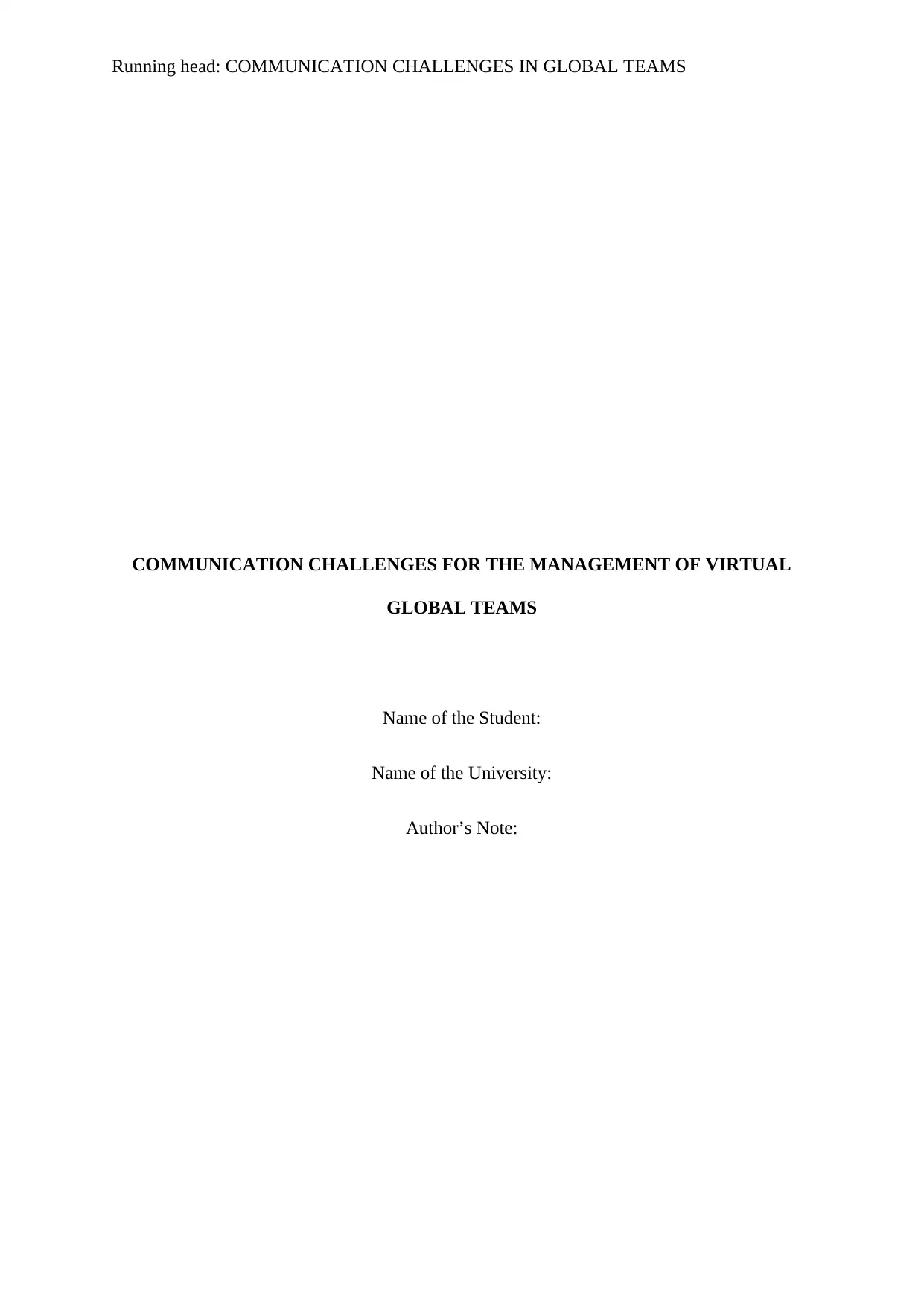
Running head: COMMUNICATION CHALLENGES IN GLOBAL TEAMS
COMMUNICATION CHALLENGES FOR THE MANAGEMENT OF VIRTUAL
GLOBAL TEAMS
Name of the Student:
Name of the University:
Author’s Note:
COMMUNICATION CHALLENGES FOR THE MANAGEMENT OF VIRTUAL
GLOBAL TEAMS
Name of the Student:
Name of the University:
Author’s Note:
Paraphrase This Document
Need a fresh take? Get an instant paraphrase of this document with our AI Paraphraser
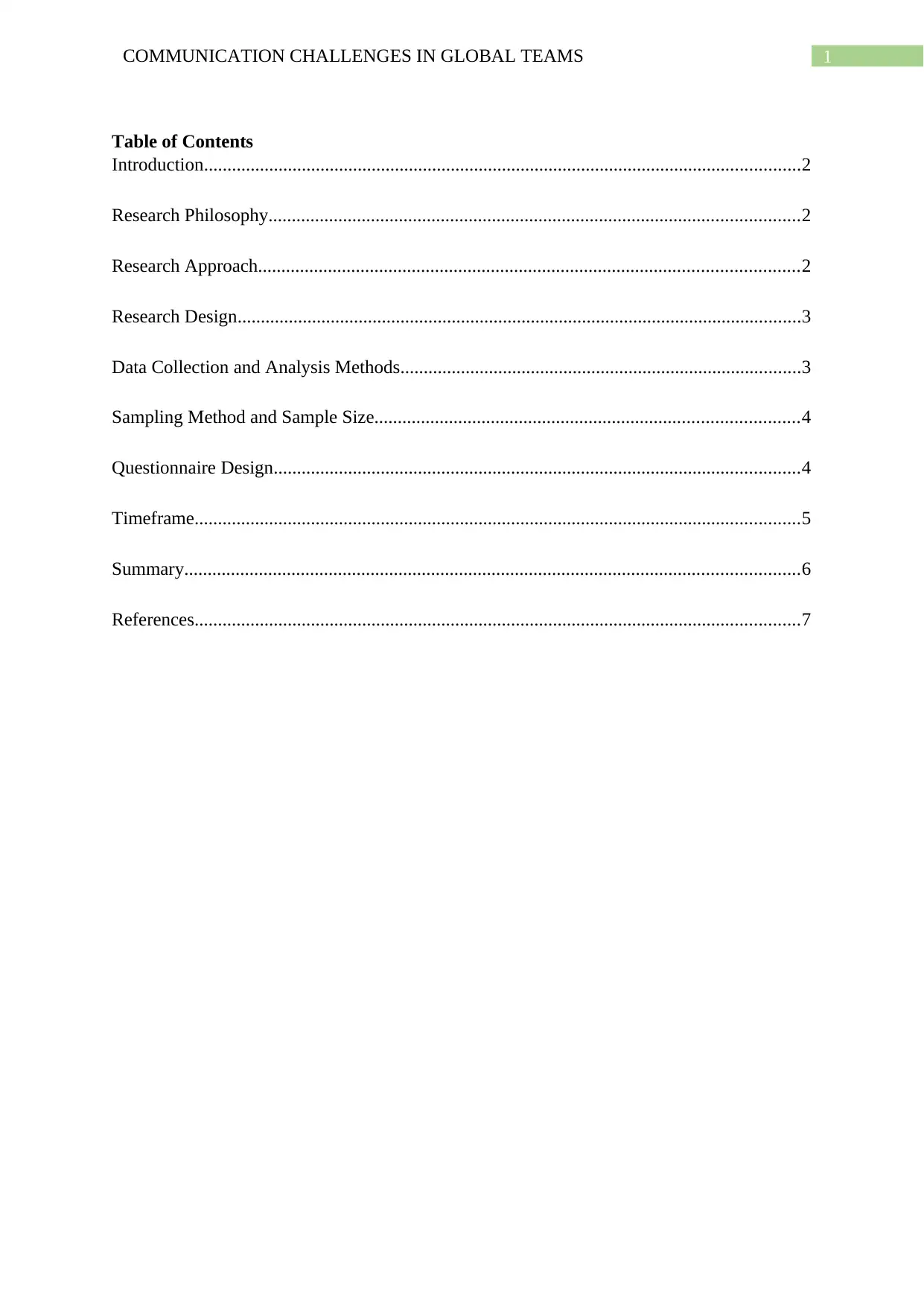
1COMMUNICATION CHALLENGES IN GLOBAL TEAMS
Table of Contents
Introduction................................................................................................................................2
Research Philosophy..................................................................................................................2
Research Approach....................................................................................................................2
Research Design.........................................................................................................................3
Data Collection and Analysis Methods......................................................................................3
Sampling Method and Sample Size...........................................................................................4
Questionnaire Design.................................................................................................................4
Timeframe..................................................................................................................................5
Summary....................................................................................................................................6
References..................................................................................................................................7
Table of Contents
Introduction................................................................................................................................2
Research Philosophy..................................................................................................................2
Research Approach....................................................................................................................2
Research Design.........................................................................................................................3
Data Collection and Analysis Methods......................................................................................3
Sampling Method and Sample Size...........................................................................................4
Questionnaire Design.................................................................................................................4
Timeframe..................................................................................................................................5
Summary....................................................................................................................................6
References..................................................................................................................................7
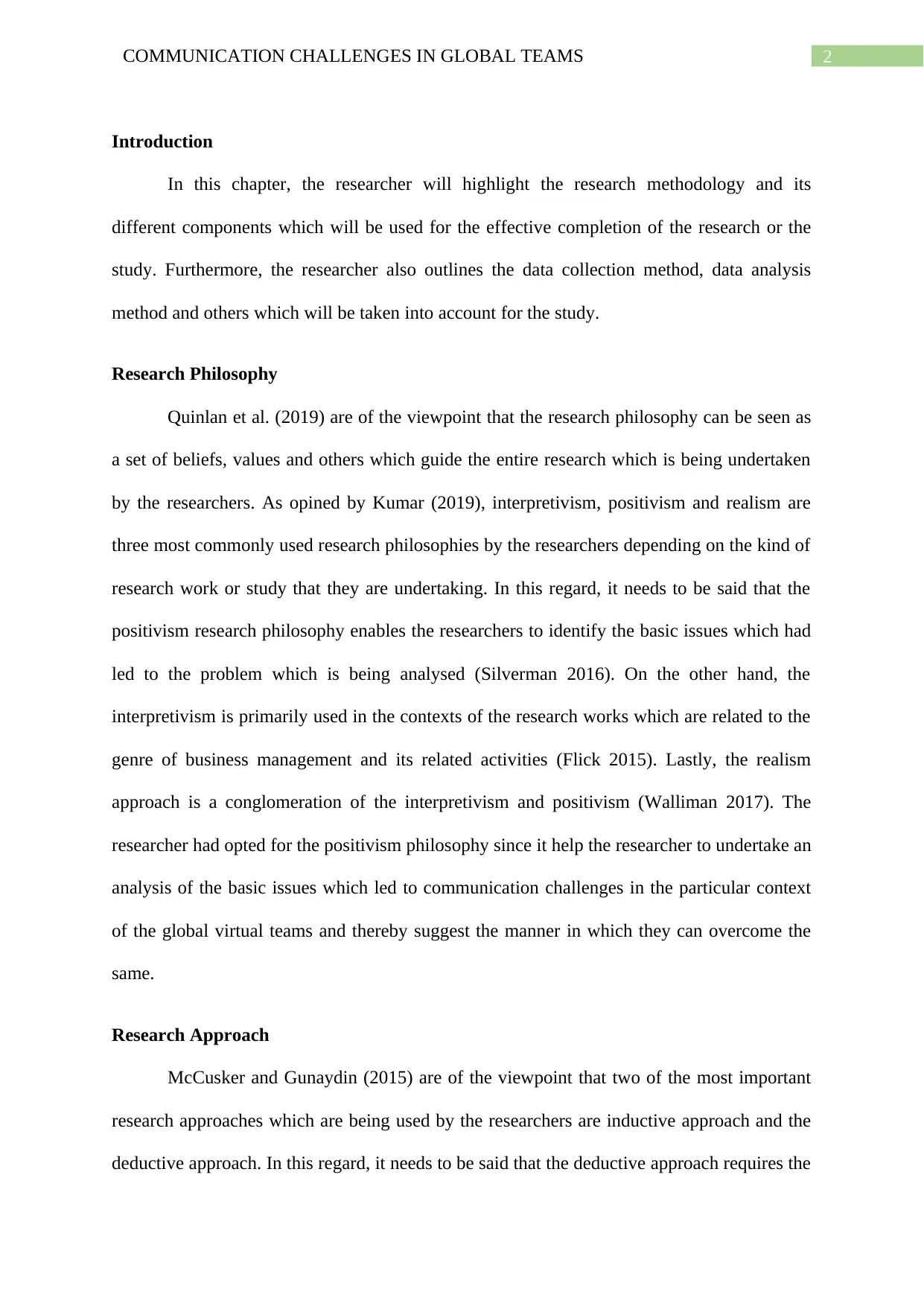
2COMMUNICATION CHALLENGES IN GLOBAL TEAMS
Introduction
In this chapter, the researcher will highlight the research methodology and its
different components which will be used for the effective completion of the research or the
study. Furthermore, the researcher also outlines the data collection method, data analysis
method and others which will be taken into account for the study.
Research Philosophy
Quinlan et al. (2019) are of the viewpoint that the research philosophy can be seen as
a set of beliefs, values and others which guide the entire research which is being undertaken
by the researchers. As opined by Kumar (2019), interpretivism, positivism and realism are
three most commonly used research philosophies by the researchers depending on the kind of
research work or study that they are undertaking. In this regard, it needs to be said that the
positivism research philosophy enables the researchers to identify the basic issues which had
led to the problem which is being analysed (Silverman 2016). On the other hand, the
interpretivism is primarily used in the contexts of the research works which are related to the
genre of business management and its related activities (Flick 2015). Lastly, the realism
approach is a conglomeration of the interpretivism and positivism (Walliman 2017). The
researcher had opted for the positivism philosophy since it help the researcher to undertake an
analysis of the basic issues which led to communication challenges in the particular context
of the global virtual teams and thereby suggest the manner in which they can overcome the
same.
Research Approach
McCusker and Gunaydin (2015) are of the viewpoint that two of the most important
research approaches which are being used by the researchers are inductive approach and the
deductive approach. In this regard, it needs to be said that the deductive approach requires the
Introduction
In this chapter, the researcher will highlight the research methodology and its
different components which will be used for the effective completion of the research or the
study. Furthermore, the researcher also outlines the data collection method, data analysis
method and others which will be taken into account for the study.
Research Philosophy
Quinlan et al. (2019) are of the viewpoint that the research philosophy can be seen as
a set of beliefs, values and others which guide the entire research which is being undertaken
by the researchers. As opined by Kumar (2019), interpretivism, positivism and realism are
three most commonly used research philosophies by the researchers depending on the kind of
research work or study that they are undertaking. In this regard, it needs to be said that the
positivism research philosophy enables the researchers to identify the basic issues which had
led to the problem which is being analysed (Silverman 2016). On the other hand, the
interpretivism is primarily used in the contexts of the research works which are related to the
genre of business management and its related activities (Flick 2015). Lastly, the realism
approach is a conglomeration of the interpretivism and positivism (Walliman 2017). The
researcher had opted for the positivism philosophy since it help the researcher to undertake an
analysis of the basic issues which led to communication challenges in the particular context
of the global virtual teams and thereby suggest the manner in which they can overcome the
same.
Research Approach
McCusker and Gunaydin (2015) are of the viewpoint that two of the most important
research approaches which are being used by the researchers are inductive approach and the
deductive approach. In this regard, it needs to be said that the deductive approach requires the
⊘ This is a preview!⊘
Do you want full access?
Subscribe today to unlock all pages.

Trusted by 1+ million students worldwide
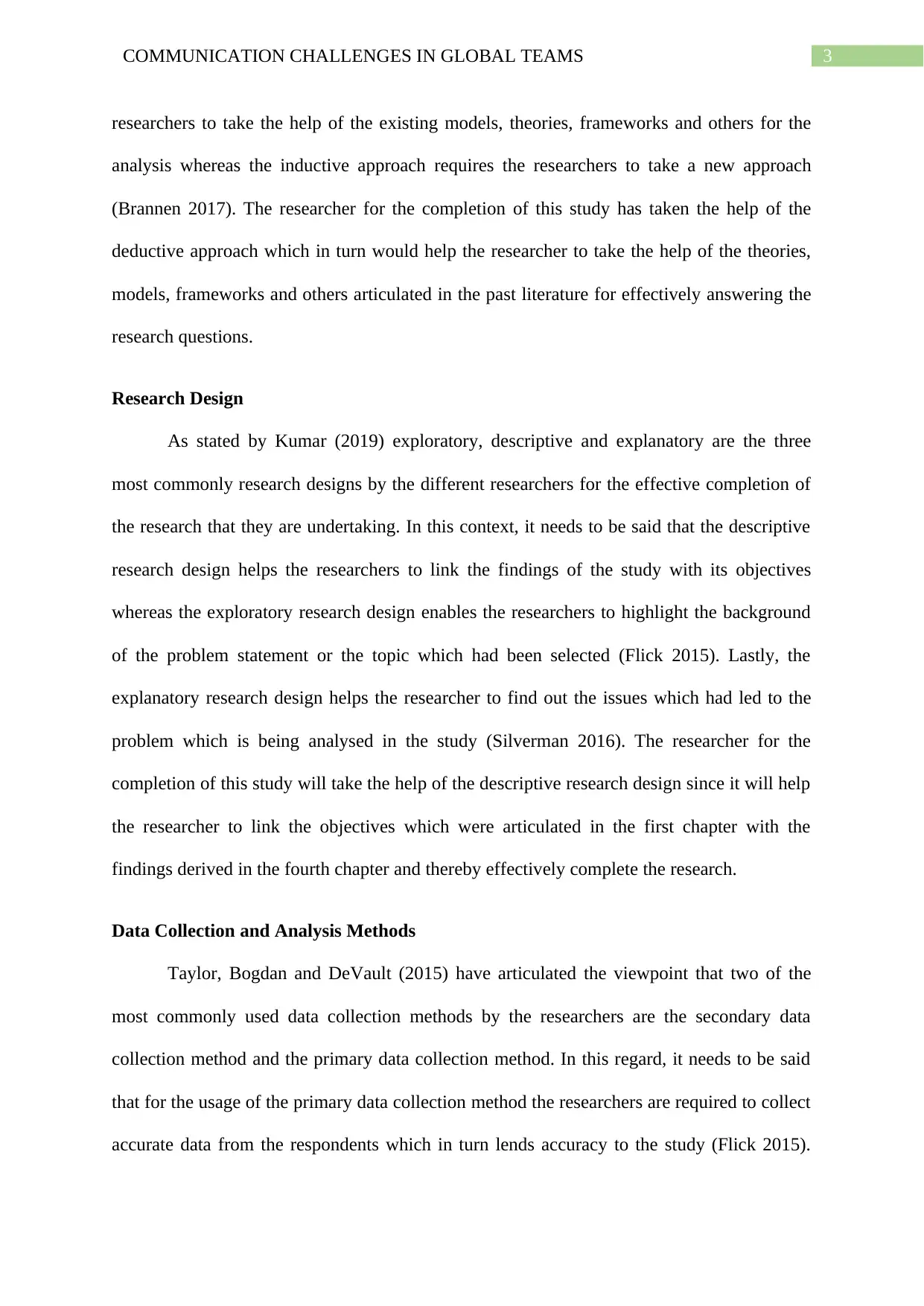
3COMMUNICATION CHALLENGES IN GLOBAL TEAMS
researchers to take the help of the existing models, theories, frameworks and others for the
analysis whereas the inductive approach requires the researchers to take a new approach
(Brannen 2017). The researcher for the completion of this study has taken the help of the
deductive approach which in turn would help the researcher to take the help of the theories,
models, frameworks and others articulated in the past literature for effectively answering the
research questions.
Research Design
As stated by Kumar (2019) exploratory, descriptive and explanatory are the three
most commonly research designs by the different researchers for the effective completion of
the research that they are undertaking. In this context, it needs to be said that the descriptive
research design helps the researchers to link the findings of the study with its objectives
whereas the exploratory research design enables the researchers to highlight the background
of the problem statement or the topic which had been selected (Flick 2015). Lastly, the
explanatory research design helps the researcher to find out the issues which had led to the
problem which is being analysed in the study (Silverman 2016). The researcher for the
completion of this study will take the help of the descriptive research design since it will help
the researcher to link the objectives which were articulated in the first chapter with the
findings derived in the fourth chapter and thereby effectively complete the research.
Data Collection and Analysis Methods
Taylor, Bogdan and DeVault (2015) have articulated the viewpoint that two of the
most commonly used data collection methods by the researchers are the secondary data
collection method and the primary data collection method. In this regard, it needs to be said
that for the usage of the primary data collection method the researchers are required to collect
accurate data from the respondents which in turn lends accuracy to the study (Flick 2015).
researchers to take the help of the existing models, theories, frameworks and others for the
analysis whereas the inductive approach requires the researchers to take a new approach
(Brannen 2017). The researcher for the completion of this study has taken the help of the
deductive approach which in turn would help the researcher to take the help of the theories,
models, frameworks and others articulated in the past literature for effectively answering the
research questions.
Research Design
As stated by Kumar (2019) exploratory, descriptive and explanatory are the three
most commonly research designs by the different researchers for the effective completion of
the research that they are undertaking. In this context, it needs to be said that the descriptive
research design helps the researchers to link the findings of the study with its objectives
whereas the exploratory research design enables the researchers to highlight the background
of the problem statement or the topic which had been selected (Flick 2015). Lastly, the
explanatory research design helps the researcher to find out the issues which had led to the
problem which is being analysed in the study (Silverman 2016). The researcher for the
completion of this study will take the help of the descriptive research design since it will help
the researcher to link the objectives which were articulated in the first chapter with the
findings derived in the fourth chapter and thereby effectively complete the research.
Data Collection and Analysis Methods
Taylor, Bogdan and DeVault (2015) have articulated the viewpoint that two of the
most commonly used data collection methods by the researchers are the secondary data
collection method and the primary data collection method. In this regard, it needs to be said
that for the usage of the primary data collection method the researchers are required to collect
accurate data from the respondents which in turn lends accuracy to the study (Flick 2015).
Paraphrase This Document
Need a fresh take? Get an instant paraphrase of this document with our AI Paraphraser
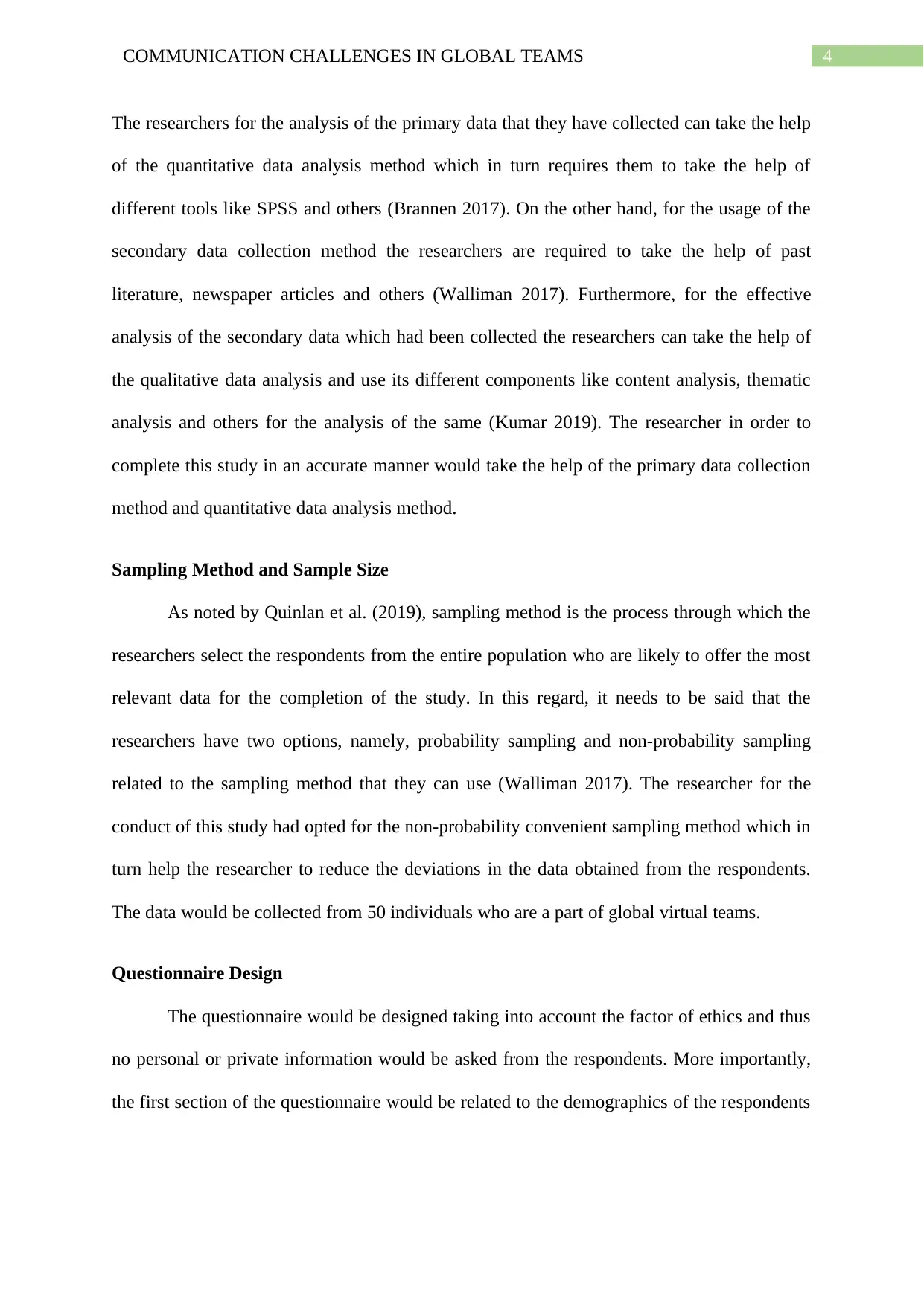
4COMMUNICATION CHALLENGES IN GLOBAL TEAMS
The researchers for the analysis of the primary data that they have collected can take the help
of the quantitative data analysis method which in turn requires them to take the help of
different tools like SPSS and others (Brannen 2017). On the other hand, for the usage of the
secondary data collection method the researchers are required to take the help of past
literature, newspaper articles and others (Walliman 2017). Furthermore, for the effective
analysis of the secondary data which had been collected the researchers can take the help of
the qualitative data analysis and use its different components like content analysis, thematic
analysis and others for the analysis of the same (Kumar 2019). The researcher in order to
complete this study in an accurate manner would take the help of the primary data collection
method and quantitative data analysis method.
Sampling Method and Sample Size
As noted by Quinlan et al. (2019), sampling method is the process through which the
researchers select the respondents from the entire population who are likely to offer the most
relevant data for the completion of the study. In this regard, it needs to be said that the
researchers have two options, namely, probability sampling and non-probability sampling
related to the sampling method that they can use (Walliman 2017). The researcher for the
conduct of this study had opted for the non-probability convenient sampling method which in
turn help the researcher to reduce the deviations in the data obtained from the respondents.
The data would be collected from 50 individuals who are a part of global virtual teams.
Questionnaire Design
The questionnaire would be designed taking into account the factor of ethics and thus
no personal or private information would be asked from the respondents. More importantly,
the first section of the questionnaire would be related to the demographics of the respondents
The researchers for the analysis of the primary data that they have collected can take the help
of the quantitative data analysis method which in turn requires them to take the help of
different tools like SPSS and others (Brannen 2017). On the other hand, for the usage of the
secondary data collection method the researchers are required to take the help of past
literature, newspaper articles and others (Walliman 2017). Furthermore, for the effective
analysis of the secondary data which had been collected the researchers can take the help of
the qualitative data analysis and use its different components like content analysis, thematic
analysis and others for the analysis of the same (Kumar 2019). The researcher in order to
complete this study in an accurate manner would take the help of the primary data collection
method and quantitative data analysis method.
Sampling Method and Sample Size
As noted by Quinlan et al. (2019), sampling method is the process through which the
researchers select the respondents from the entire population who are likely to offer the most
relevant data for the completion of the study. In this regard, it needs to be said that the
researchers have two options, namely, probability sampling and non-probability sampling
related to the sampling method that they can use (Walliman 2017). The researcher for the
conduct of this study had opted for the non-probability convenient sampling method which in
turn help the researcher to reduce the deviations in the data obtained from the respondents.
The data would be collected from 50 individuals who are a part of global virtual teams.
Questionnaire Design
The questionnaire would be designed taking into account the factor of ethics and thus
no personal or private information would be asked from the respondents. More importantly,
the first section of the questionnaire would be related to the demographics of the respondents
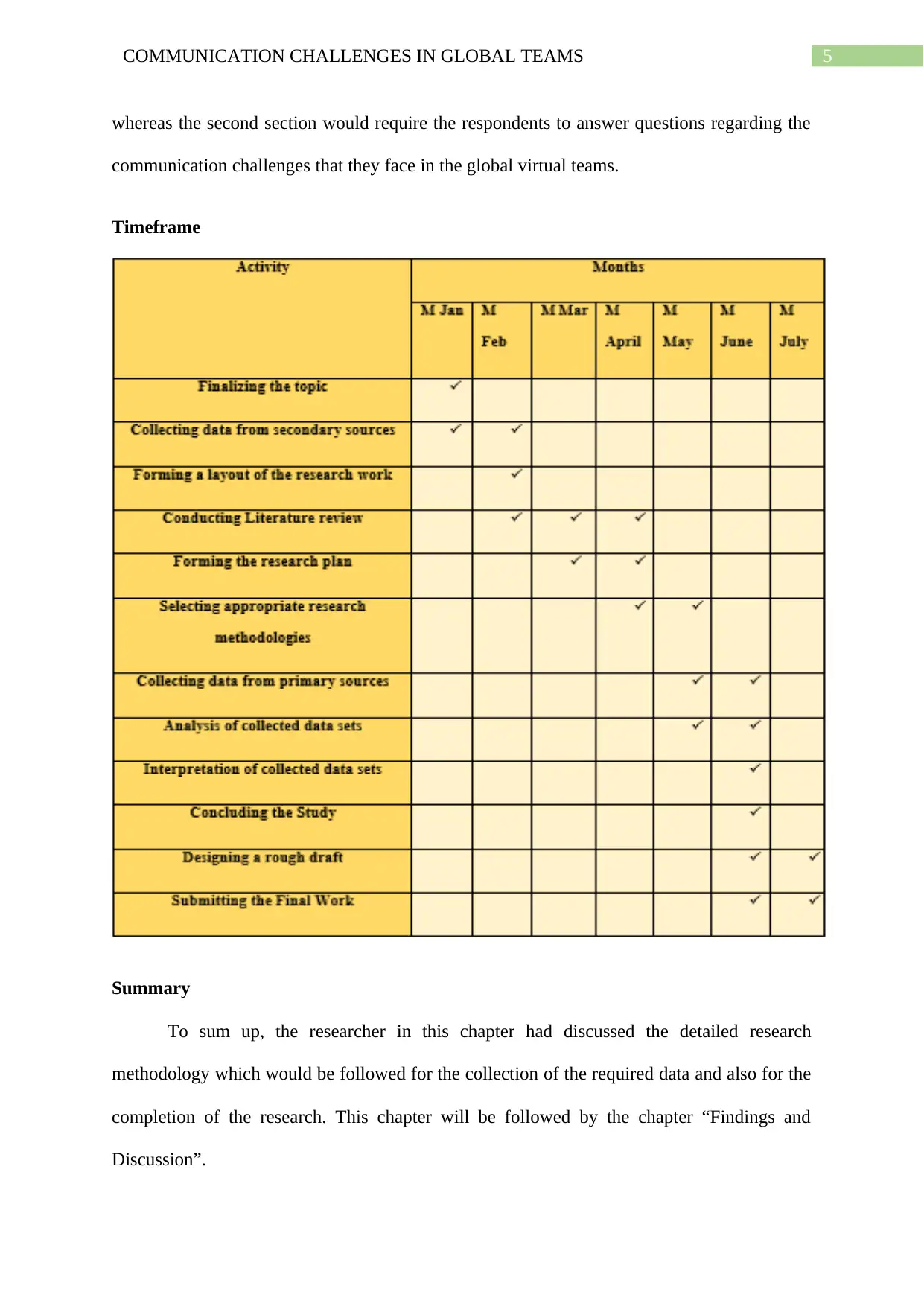
5COMMUNICATION CHALLENGES IN GLOBAL TEAMS
whereas the second section would require the respondents to answer questions regarding the
communication challenges that they face in the global virtual teams.
Timeframe
Summary
To sum up, the researcher in this chapter had discussed the detailed research
methodology which would be followed for the collection of the required data and also for the
completion of the research. This chapter will be followed by the chapter “Findings and
Discussion”.
whereas the second section would require the respondents to answer questions regarding the
communication challenges that they face in the global virtual teams.
Timeframe
Summary
To sum up, the researcher in this chapter had discussed the detailed research
methodology which would be followed for the collection of the required data and also for the
completion of the research. This chapter will be followed by the chapter “Findings and
Discussion”.
⊘ This is a preview!⊘
Do you want full access?
Subscribe today to unlock all pages.

Trusted by 1+ million students worldwide

6COMMUNICATION CHALLENGES IN GLOBAL TEAMS
Paraphrase This Document
Need a fresh take? Get an instant paraphrase of this document with our AI Paraphraser
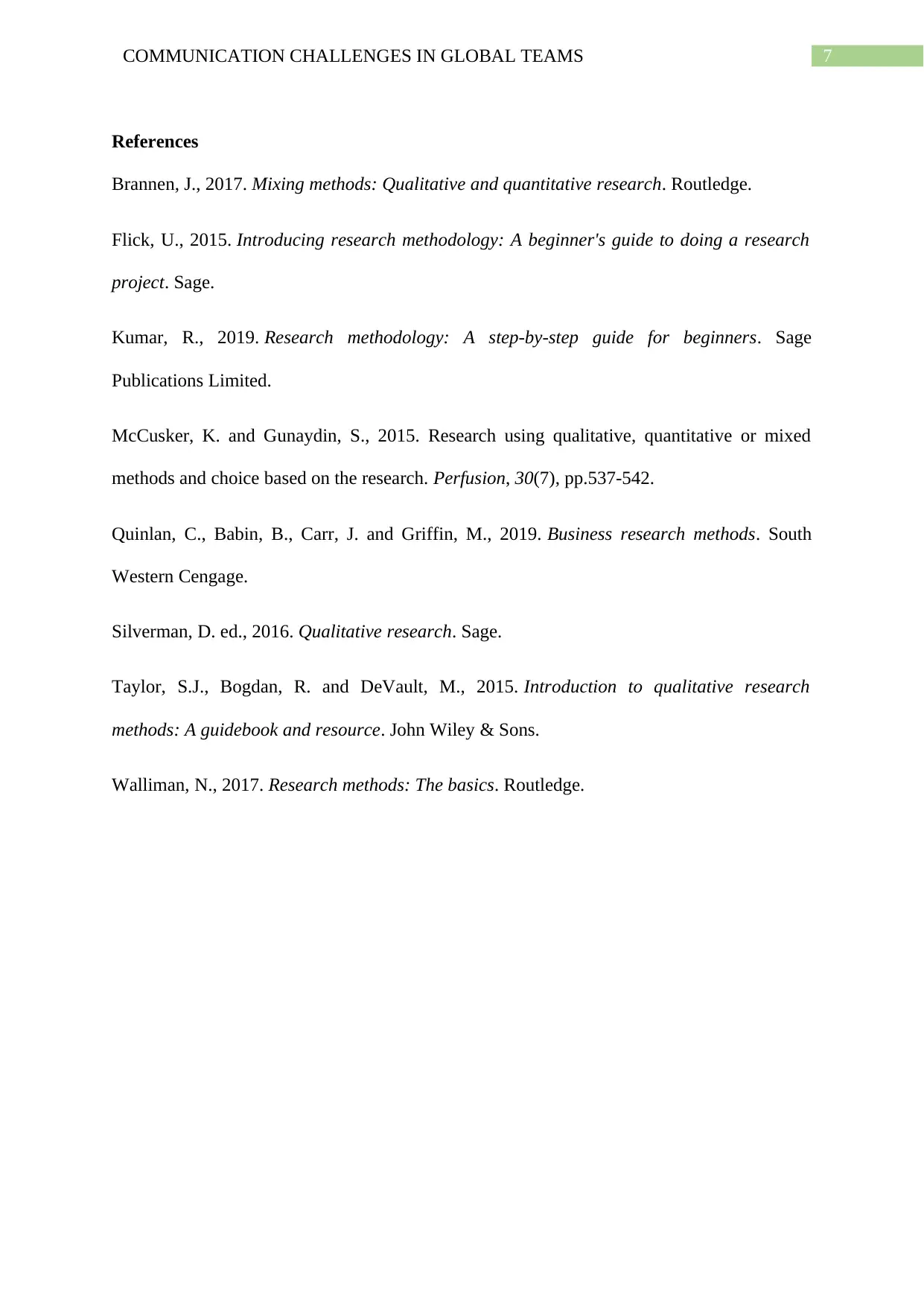
7COMMUNICATION CHALLENGES IN GLOBAL TEAMS
References
Brannen, J., 2017. Mixing methods: Qualitative and quantitative research. Routledge.
Flick, U., 2015. Introducing research methodology: A beginner's guide to doing a research
project. Sage.
Kumar, R., 2019. Research methodology: A step-by-step guide for beginners. Sage
Publications Limited.
McCusker, K. and Gunaydin, S., 2015. Research using qualitative, quantitative or mixed
methods and choice based on the research. Perfusion, 30(7), pp.537-542.
Quinlan, C., Babin, B., Carr, J. and Griffin, M., 2019. Business research methods. South
Western Cengage.
Silverman, D. ed., 2016. Qualitative research. Sage.
Taylor, S.J., Bogdan, R. and DeVault, M., 2015. Introduction to qualitative research
methods: A guidebook and resource. John Wiley & Sons.
Walliman, N., 2017. Research methods: The basics. Routledge.
References
Brannen, J., 2017. Mixing methods: Qualitative and quantitative research. Routledge.
Flick, U., 2015. Introducing research methodology: A beginner's guide to doing a research
project. Sage.
Kumar, R., 2019. Research methodology: A step-by-step guide for beginners. Sage
Publications Limited.
McCusker, K. and Gunaydin, S., 2015. Research using qualitative, quantitative or mixed
methods and choice based on the research. Perfusion, 30(7), pp.537-542.
Quinlan, C., Babin, B., Carr, J. and Griffin, M., 2019. Business research methods. South
Western Cengage.
Silverman, D. ed., 2016. Qualitative research. Sage.
Taylor, S.J., Bogdan, R. and DeVault, M., 2015. Introduction to qualitative research
methods: A guidebook and resource. John Wiley & Sons.
Walliman, N., 2017. Research methods: The basics. Routledge.
1 out of 8
Related Documents
Your All-in-One AI-Powered Toolkit for Academic Success.
+13062052269
info@desklib.com
Available 24*7 on WhatsApp / Email
![[object Object]](/_next/static/media/star-bottom.7253800d.svg)
Unlock your academic potential
Copyright © 2020–2025 A2Z Services. All Rights Reserved. Developed and managed by ZUCOL.





